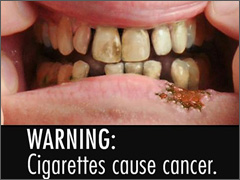
One of several new images the FDA will require cigarette manufacturers to feature on their packaging soon.
The FDA is currently in the process of choosing nine graphic images depicting the results of smoking that it will require cigarette manufacturers to feature prominently on their packaging to deter people from smoking.
We at the League find this development very interesting given our use of graphic images of the victims of abortion in our Face the Truth campaigns to alter public opinion on the abortion issue. Graphic images show the true, stomach-churning face of abortion like nothing else can, so it’s easy to see where the FDA is coming from with this campaign.
Graphic Images Work
Graphic images in the public square have a long history of effectiveness in changing hearts and minds on issues ranging from genocide to racism to drug use to public health. When people see the disastrous and disgusting results of a practice they may otherwise have considered harmless, they very often see the seriousness of the issue and change their minds and behavior.
In a CBS news story on the topic, Dr. David Hammond, professor of health studies at the University of Waterloo in Canada said:
Strong, graphic, aesthetically displeasing images have been shown to be very effective at deterring smoking, especially with kids. There is good reason for having graphically strong pictures as long as they depict the health effects truthfully.
Usually the public understands the need for such graphic images if the gravity of the issue warrants them. Images of the Nazi concentration camps, the victims of slavery, meth addicts or the ruined organs of heavy drinkers and smokers are staples of grade school textbooks and public awareness campaigns. And, though people may be disturbed, they understand the necessity of showing such images so that people can truly understand the destruction that those things cause.
Abortion is the Exception
But when images of victims of abortion are shown, as the League regularly does with our Face the Truth campaigns, we invariably receive complaints from passersby who feel that showing the reality of abortion crosses a line of decency that these other photos do not.
Why do people feel differently about pictures of abortion than they do about other uses of graphic images? One fundamental reason is that it forces people to think about something they would rather not think about.
Statistics say that one out of four women of child-bearing age in the US has had an abortion. If that’s the case, that means that nearly every single person in the country has been affected by abortion in one way or another.
Whether they had an abortion, paid for it, performed it, condoned it, sat idly by while it happened, or just know someone who had one, pretty much everyone who sees the League’s graphic pictures of abortion has some personal connection to the issue.
So it’s understandable that being confronted with the reality of “choice” makes people upset. For people to continue to condone the tragedy of abortion, it is essential that they not be forced to see what it really is.
Is Abortion a Bad Thing?
We’ve seen a lot of use of graphic images in the media lately, from the Time Magazine cover featuring a woman mutilated by the Taliban to images of the victims of car accidents cause by texting while driving. It seems that it’s been generally acknowledged that graphic images are appropriate if used to display a hidden evil or dissuade people (especially youth) from bad or destructive behavior.
And that’s exactly why people have a problem with graphic images of abortion but not graphic images in other contexts: Graphic images imply that there is something wrong with the thing they portray. To admit that it’s appropriate to use graphic images of abortion, one must first admit that there is something wrong with abortion. Many people are simply unwilling to do this, again often motivated by their own involvement in abortion.
FDA commissioner Dr. Margaret Hamburg had this to say about the cigarette images:
We need to make sure that anyone who is considering smoking, particularly kids, fully appreciate the consequences of cigarette use. And that means presenting the facts, directly and honestly.
But if we’re willing to use graphic images to fully inform about something that might kill our young people, how much more should we be willing to bust out the graphic signs for something that kills 3,500 young people every single day?
